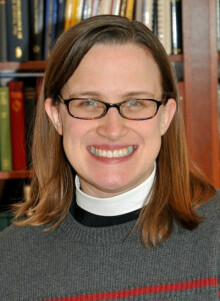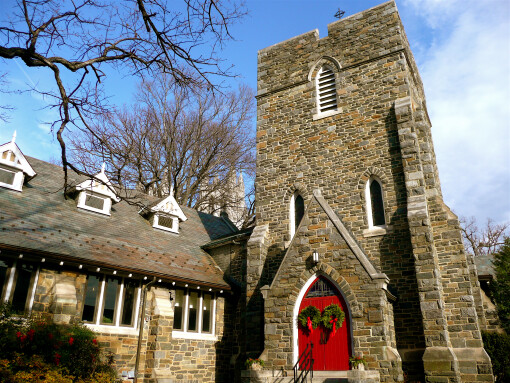Vision Problems

Series: Lent
Speaker: The Rev'd Emily Griffin
I wonder what we really need to see clearly. I know I need glasses for most things. Until recently, I would have told you that I’m shortsighted. I can see things up close just fine; it’s those things in the distance, on the far horizon that I have trouble with. Only now, the up close stuff is starting to be a problem too. I’ve started doing this (pulling my glasses down) when I read my phone in the morning. Nothing catastrophic, I realize – just middle age staring me down, showing me up again on what I thought I saw so clearly.
Some think we need a telescope to see the Bible clearly; it’s that far removed from us, so far that it feels like another planet at times. Others might settle for binoculars; they acknowledge some distance, but admit that the figures we read about aren’t alien creatures. Strip away the animal sacrifices, some of the strange sounding names, the admittedly odd uses for mud and saliva – these people sound a lot like us.
Take Samuel in today’s first reading. His thoughts are reasonable, based on what he can see at that moment. The LORD tells him to go and anoint a new king, when Samuel knows all too well that the job’s already taken by an insecure, volatile, mentally unstable monarch – one he happened to anoint just chapters before. It’s within the LORD’s rights to call an audible, so Samuel goes along with this (to-all-appearances anyway) treasonous plan. When he sees Jesse’s oldest son, the seemingly best and brightest, the modern campaigner’s dream, he assumes this is the one, but the LORD says no. “The LORD does not see as mortals see (Samuel is told); they look on the outward appearance, but the LORD looks on the heart.” OK. So there are some things we cannot see, no matter how close or far we think we are. In this case, only hindsight would make the LORD’s logic clear. Looking back, we know to look for good things from Bethlehem. We know that God likes the underdog. Of course, David was a younger son. Of course, he was a shepherd. But Samuel can’t see any of these things for the signs they are; it’s listening, not seeing this time, that guides him into making the right choice.
So is that all we get from today’s lessons – “don’t judge a book by its cover”? If so, while it’s good advice (if a bit clichéd), I’m not sure it’s good news. So we shouldn’t mistake beauty for goodness. Fair enough. The real question – at least for some of us – is what hope is there for those of us stumbling around in the dark this Lenten season, who can’t see up close clearly anymore, much less far away? We might not be able to predict or control what’s happening on the national scene or on the world stage, but we like to think we know the people closest to us. We think we see them clearly at least.
Today’s Gospel reading shakes that assumption to the core. Let’s start with the disciples. They don’t really see the man born blind; they see an object lesson. They ask Jesus who sinned – this man or his parents – that he was born this way. If there’s suffering, someone must have done something wrong. Or so the thinking went at the time. If they were that interested in the man’s personal life, they could have asked him. But no – they don’t want a complicated truth. They don’t want a life story that’s as messy as theirs. They just want to know who’s to blame. If we can blame something or someone, we can prevent what’s beyond our control from happening again, right? So “who sinned?”
Jesus rejects the premise of the question. “Neither this man nor his parents sinned; he was born blind so that God’s works might be revealed in him.” What does that mean? Well, among other things, it means that this man reveals something about God before Jesus heals him – not just after he receives his sight. It’s his blindness that has sharpened his other senses, that’s revealed the spiritual blindness of those around him. He reveals something about God in his blindness, in his disability. For those of us with disabilities that aren’t likely to change or get better any time soon, that’s good news. What if any crack in the armor is a chance for God’s light to shine through?
It’s tempting in Jesus’ healing stories to treat the people being healed as objects of pity, but John, our Gospel writer, won’t let that happen here. This man is as fully formed a character as any. He’s a little mouthy and sarcastic; he doesn’t like needless repetition any more than we do; 2000 years later, he does sound like us. What’s most remarkable to me, though, is his humility. He doesn’t claim to know who’s a sinner and who’s not, that he can see what’s on another person’s heart. It’s none of his business. He leaves that to God. It’s those with physical sight – who claim to see everything and everyone clearly – who prove their own blindness.
Note that the man doesn’t ask for healing. He doesn’t have to beg for Jesus’ attention. Before he knows what’s happening, Jesus spreads mud on his eyes and tells him to go wash. Well, he has to now, doesn’t he? So he goes to the pool and washes – and he can see. He makes his way back, but he can’t find Jesus. He doesn’t know what he looks like yet. But he sure doesn’t sound like the people around him now. They acted like they never saw him when he was blind, but now that he can see, they won’t leave him alone. They keep asking how it happened – as if more information would change the outcome.
It’s not like they really care about him. If they did, they might rejoice with him. But no, it’s not really about that for them. They drag him to the Pharisees so they can join the chorus too. Who sinned? Who’s to blame? Well, the religious leaders can’t answer that one, so they turn to the man’s parents. And they, for their part, let fear take over. They’re afraid of being kicked out of their community. It’s not like the community was ever really open to them – always looking at them askance, guessing which one of them caused their son’s problems. It might not be much of a community, but it’s all they have. They’re not leaving.
With the parents a dead end, the man’s the target again. Someone needs to be the sinner – if not the man or his parents, then Jesus. When the man refuses to point fingers and, in fact, voices their very fear – that Jesus is indeed from God and that God won’t let them turn the world into “us” vs. “them” any more – they blame the man again and drive him out.
I wish I could say that no one enters the Christian community and experiences that kind of judgment, that our tendency to point the finger and identify the sinners in our midst died with the Pharisees. But no, we need our sinners too. We need each other’s flaws and more obvious deficits to hide our own. We use them to hide from what we don’t want to face in ourselves – that we’re blind too, no matter how well we think we see. That’s the Pharisees’ real fear, isn’t it: “Surely we’re not blind, are we?”
Or as Carl Jung once put it, “What if I should discover that the least among them all, the poorest of all beggars…the very enemy himself – that these are within me…that I myself am the enemy who must be loved – what then? As a rule, the Christian’s attitude is then reversed; there is no longer any question of love or long-suffering; we…rage against ourselves. We hide it from the world; we refuse to admit ever having met this least among the lowly in ourselves.”
So what’s the alternative? Can we extend the love we’d offer to others to ourselves? The truth is, it’s impossible for us to see ourselves clearly – no matter what kind of glasses we have. We’re simply too close. We don’t have the perspective to see either our true beauty or our less than attractive sides. That’s part of why we have community – to be our mirrors for us (gracious ones, we hope), to help us with our inevitable blind spots, all that we can’t see on our own.
It’s also part of why we have Lent – because we need practice listening to each other when what we see will only distract us. We need practice listening for God, the only One qualified to judge another person’s heart. And we need practice listening to our own deepest selves – so we can stop focusing on the wrong things (like who’s the sinner) and start focusing on how we might be more loving mirrors instead.
Perhaps then we’ll be able to sense what we can only really see in hindsight. Looking back on today’s stories, we can see even with our binoculars what those involved couldn’t. We see, for example, that Samuel, for all his blindness, did end up making the right choice with David. I don’t know about you, but for me, that’s good news. That it’s possible to make good choices after having made bad ones – especially when we learn to listen first. That if we’re willing to look back on and admit our mistakes and missteps, there’s a chance we may actually learn from them. For me anyway, that’s good news.
It’s also good to know that there may indeed be a divine pattern in what seems like chance to us; we might just not have the distance to see it yet. No matter how we got here, we might be exactly where we’re supposed to be in order to receive what God has for us next. The man born blind in today’s Gospel couldn’t have been in a better place at a better time. Yet he had no way of knowing that. He had no way to see what was coming – literally or figuratively. He didn’t know to ask Jesus for anything, and yet he was the one granted sight. When we have the humility to admit that we can’t see everything, that the people close to us are just as much of a mystery as those who are far away, we create space for God to bring the healing and hope we don’t even know how to ask for on our own. In the Name of the One who does see clearly and can do more for us than we can ask or imagine – Amen.
 Welcome to St. Alban’s Church! Every Sunday, and most days in between, people gather in this place to worship, to learn, to grow, to share the joys and struggles of our lives, and to seek God’s grace in the midst of our lives. We do not come because we have it all figured out, but because we are seeking light on the way. We come as we are and welcome one another.
Welcome to St. Alban’s Church! Every Sunday, and most days in between, people gather in this place to worship, to learn, to grow, to share the joys and struggles of our lives, and to seek God’s grace in the midst of our lives. We do not come because we have it all figured out, but because we are seeking light on the way. We come as we are and welcome one another.

